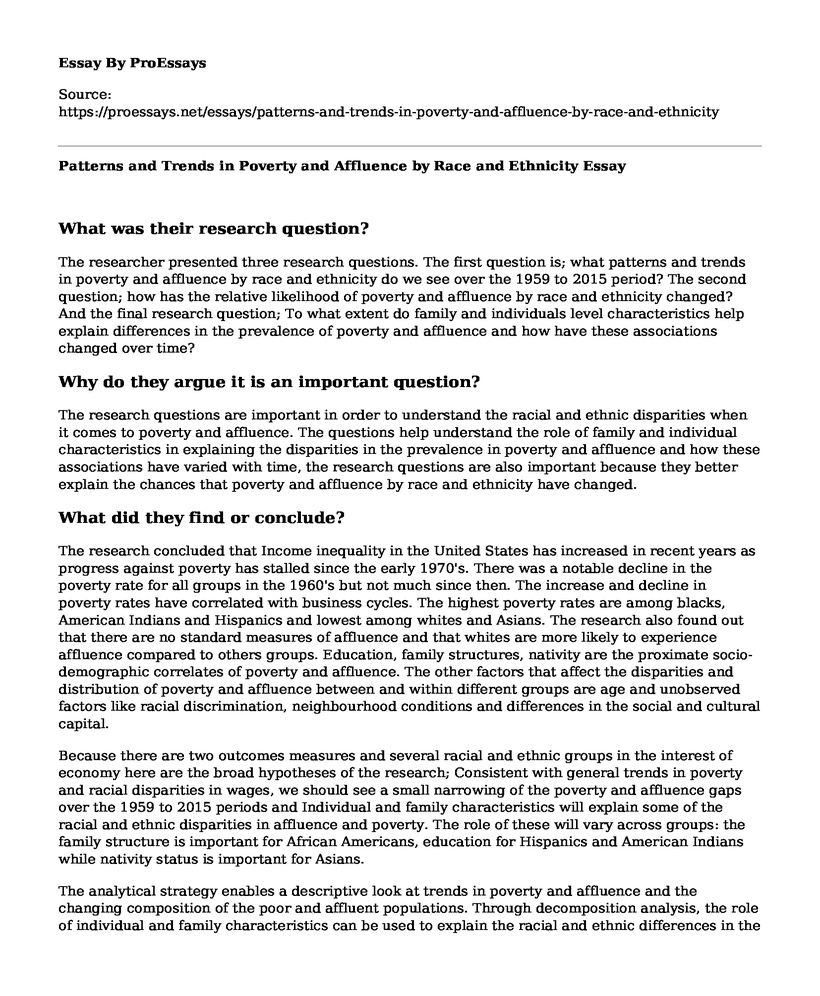What was their research question?
The researcher presented three research questions. The first question is; what patterns and trends in poverty and affluence by race and ethnicity do we see over the 1959 to 2015 period? The second question; how has the relative likelihood of poverty and affluence by race and ethnicity changed? And the final research question; To what extent do family and individuals level characteristics help explain differences in the prevalence of poverty and affluence and how have these associations changed over time?
Why do they argue it is an important question?
The research questions are important in order to understand the racial and ethnic disparities when it comes to poverty and affluence. The questions help understand the role of family and individual characteristics in explaining the disparities in the prevalence in poverty and affluence and how these associations have varied with time, the research questions are also important because they better explain the chances that poverty and affluence by race and ethnicity have changed.
What did they find or conclude?
The research concluded that Income inequality in the United States has increased in recent years as progress against poverty has stalled since the early 1970's. There was a notable decline in the poverty rate for all groups in the 1960's but not much since then. The increase and decline in poverty rates have correlated with business cycles. The highest poverty rates are among blacks, American Indians and Hispanics and lowest among whites and Asians. The research also found out that there are no standard measures of affluence and that whites are more likely to experience affluence compared to others groups. Education, family structures, nativity are the proximate socio-demographic correlates of poverty and affluence. The other factors that affect the disparities and distribution of poverty and affluence between and within different groups are age and unobserved factors like racial discrimination, neighbourhood conditions and differences in the social and cultural capital.
Because there are two outcomes measures and several racial and ethnic groups in the interest of economy here are the broad hypotheses of the research; Consistent with general trends in poverty and racial disparities in wages, we should see a small narrowing of the poverty and affluence gaps over the 1959 to 2015 periods and Individual and family characteristics will explain some of the racial and ethnic disparities in affluence and poverty. The role of these will vary across groups: the family structure is important for African Americans, education for Hispanics and American Indians while nativity status is important for Asians.
The analytical strategy enables a descriptive look at trends in poverty and affluence and the changing composition of the poor and affluent populations. Through decomposition analysis, the role of individual and family characteristics can be used to explain the racial and ethnic differences in the disparities in poverty and affluence. Decomposition which is a variant of the well-known Blinder-Oaxaca decomposition for linear regression developed for linear regression models allows for the estimation of the role of group characteristics that is education and family structures in explaining differences in poverty and affluence by race in a given period versus what remains unchanged.
The descriptive results indicate declines in poverty in the 1960's due to moderate income inequality. Poverty rates in early 1959 very high. The distribution of population by affluence indicates that Whites are underrepresented in the poverty populations and overrepresented in the affluence populations from 1960 to 2015. In 2015, the poverty populations are more diverse with Hispanics representing the largest proportion.
References
MPC Seminar Series: John Iceland | January 22, 2018 [Video file]. (2018, January 30). Retrieved from http://www.youtube.com/watch?time_continue=3045&v=3A4QU5brTBo
Cite this page
Patterns and Trends in Poverty and Affluence by Race and Ethnicity. (2022, May 26). Retrieved from https://proessays.net/essays/patterns-and-trends-in-poverty-and-affluence-by-race-and-ethnicity
If you are the original author of this essay and no longer wish to have it published on the ProEssays website, please click below to request its removal:
- General Motors Company Case Study Paper Example
- Essay Sample on Oppression and Privilege
- Immigration and Labor Markets Debate - Essay Sample
- Essay Example on Gender-Based Violence: A Global Menace to Social, Health Wellbeing
- Essay Example on Advancing Equity in Austin: Working With the City's Equity Office
- Race & Biology: 2,500 Yr Old Prejudices Still Persist - Essay Sample
- Paper Example on Enhancing Interpersonal and Communication Skills: My Work History







